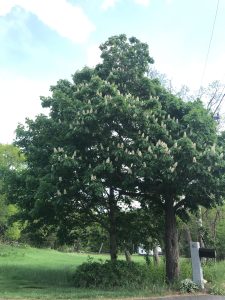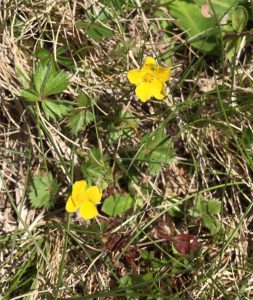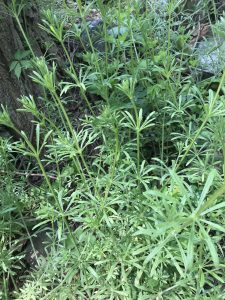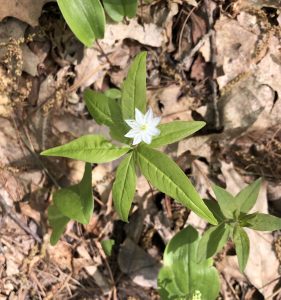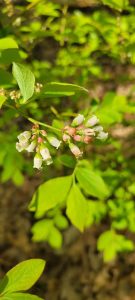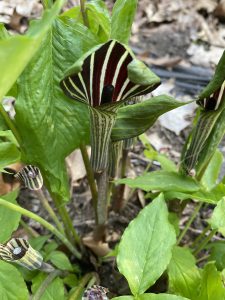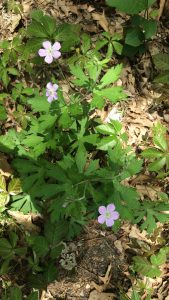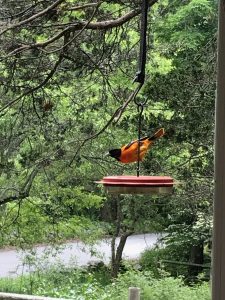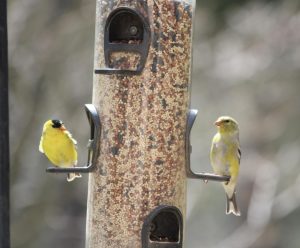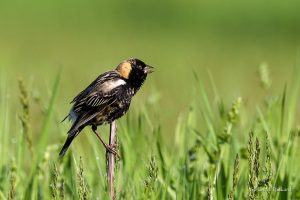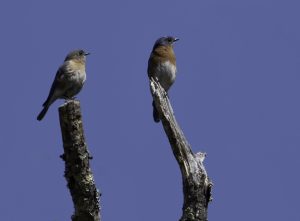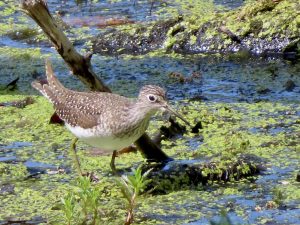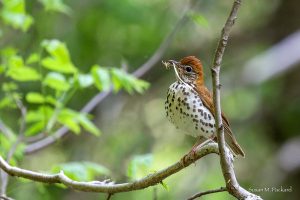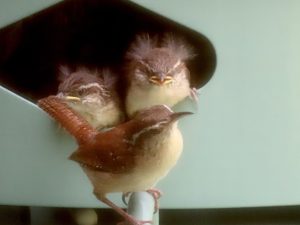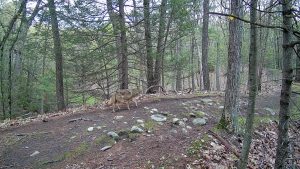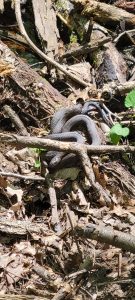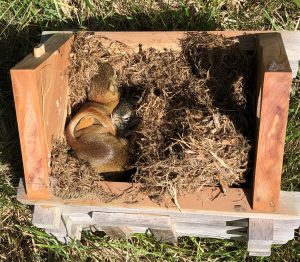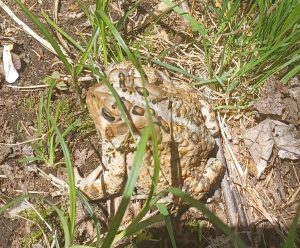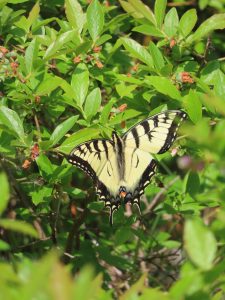Nesting is challenging business for birds, both hard work and filled with danger. According to Birding Outdoors, the overall survival rate for nestlings is 56%, with larger birds such as red-tailed hawks having much more success (88.9%) than small birds. Just this year I have a bluebird nest abandoned with 6 eggs, a robin nest which was robbed, and I witnessed crows going after a robin nest high in a pine. House wrens and house sparrows frequently attack nestlings or eggs in bluebird boxes. But not all is doom and gloom! Many people are delighted to watch birds such as phoebes, Carolina wrens, and house finches nest on or near buildings, or robins and cardinals in shrubs nearby. Canada geese swimming with a line of goslings is a lovely sight; hopefully, the babies will escape being snatched by a hawk or snapping turtle. Barn swallows, which do indeed nest in barns, are swooping in and out of two big barns in my neighborhood; I am grateful the barn owners have left the big doors open.
May 2023 Wildlife Column: Spring Blooms and Birdsongs
Written by Gwyn Loud for the Lincoln Land Conservation Trust. She welcomes your sightings, questions, and photos at 781-259-8690 or gwynloud555@gmail.com
May began with a very cool damp gray week, but since then we have been blessed with sunshine and warmer temperatures. As of this writing, we actually need more rain for our gardens. The glories of spring embrace us, with vibrant green everywhere, decorated with blooming trees, shrubs, and wildflowers. Near houses, the lilacs, fruit trees and flowering crabs seem to have flowered more profusely than ever. Nearly all our deciduous trees have leafed out, with oaks and black locusts coming in last. Birders always hope leaf-out will be delayed, as it makes it harder to see the birds! Horse chestnut trees are displaying their spectacular white flowers. Soon we shall witness the seasonal transition from the bright green of spring to the deeper greens of summer. Pollen is here, floating in the air, coating cars and windowsills, and bringing on a lot of sneezing.
On my own lawn I am trying the “No Mow May” approach for the benefit of pollinators. The result so far is that my lawn is untidy but the green is punctuated with yellow dandelions, cinquefoil, and buttercups, white and purple violets, and small flowers of ground ivy (aka gill-over-the-ground), ajuga, and chickweed. Sure enough, I can see various tiny bees in many of the flowers.
Honeysuckle is flowering and I am noticing poison ivy and cleavers (Galium aparine) everywhere. To quote a blog from the Brooklyn Botanic Gardens, “Galium aparine is an annual weed that has a weak-stemmed, creeping habit. The stems—boasting whorled leaves and tiny white flowers that bloom in spring—can grow from three to six feet in length. Stems, leaves, and fruits are all covered in hair-like, hooked-shaped bristles that easily latch onto other plants, animals, and people. This Velcro-like quality is what makes cleavers such excellent hitchhikers, and what has allowed them to be so successful in their proliferation. The species epithet aparine comes from the Greek word meaning “to seize.” In addition to cleavers, Galium aparine also goes by stickywilly, grip grass, catchweed bedstraw, goosegrass, sticky weed, sweetheart, and a host of other common names.” Cleavers are also considered edible and to have medicinal qualities (see link below).
On a woodland walk, look for Canada mayflowers (aka wild lily-of-the-valley) carpeting the woodland floor, low-bush and high-bush blueberries in bloom, and wildflowers such as starflowers and jack-in-the-pulpit. Lady’s slippers will bloom towards the end of the month. Along roadsides we can find greater celandine, wild geranium, and Dame’s rocket flowering, as well as the invasive garlic mustard; please keep pulling it before it goes to seed.
Migrating birds are still passing through, with mid-May considered the peak time for birders to see migrants such as wood warblers. Overall, songbirds are in sad decline in numbers, but small numbers of many warbler species have been spotted, such as yellow, black-and-white, yellow-rumped, black-throated green, pine, prairie, Northern parula, common yellowthroat, Northern waterthrush, chestnut-sided, Nashville, magnolia, and, at Drumlin Farm, an unusual Kentucky warbler. Birds such as Baltimore orioles, indigo buntings, rose-breasted grosbeaks, ruby-throated hummingbirds, and blue-gray gnatcatchers are now nesting, and in the woods listen for the songs of a wood thrush or ovenbird, and the nasal ascending wheep of a great-crested flycatcher from the canopy. Scarlet tanagers, sounding like “a robin with a sore throat” are also found in the woodland canopy. Bobolinks have returned from South America to Farm Meadow and Drumlin Farm, and male American goldfinches are now in their striking yellow and black breeding garb. Other birds of note recently seen include blue-headed vireos, an orchard oriole, Eastern kingbirds, mockingbirds, Savannah and field sparrows, and a couple of American pipits. A solitary sandpiper, a shorebird which which prefers fresh-water, was found by a pond on Winter St. and a pair of great blue herons is nesting in a pine tree along Stony Brook on the Harrington property. Participants in a bird walk at the Baker Bridge fields were happy to see an osprey high overhead and a Northern harrier, cruising low as it hunted for rodents. Many people are enjoying using the “Merlin” app on their phones, allowing them to know what birds are singing nearby.
Carol Roede wrote, with accompanying photos, about a Carolina wren nest she has been watching: “Well, it was an exciting day here, as it was time for our propane tank babies to fly the coop. I could tell something was up – the parents would go in there and give the hatchlings a pep talk and show them all the exits, and occasionally bring a grub but mostly just yap at them. Finally two fledged and the other two were just hunkered down in there, and the parents came back about a half hour later and gave those two another pep talk until they came out. Of the six eggs, four had hatched.”
What should you do if you find a baby bird on the ground? In nearly all cases it is best to leave it alone as, unknown to us, the parent is probably nearby, well aware of the situation and will take care of it. If you can see a nest from which it fell, you could gently put it back in the nest. The same advice holds for finding baby mammals, such as fawns or baby rabbits. Rabbits especially stay away from their young so as not to attract predators, and does will return at dusk to nurse fawns.
Many observers have reported seeing mammals such as fishers, beavers, woodchucks, and deer, and one walker had a staring contest with a young coyote near Farm Meadow (the human won). I received a report of a dead skunk on Codman road; I rarely hear of skunks (alive) these days. Several people have noticed fewer gray squirrels than usual this spring; could it be because last fall was not a big mast year, i.e. there were fewer acorns to keep the squirrels fed all winter? Red squirrels raised a family in a neighbor’s bird box.
Garter snakes seem plentiful this spring, and a few people have reported northern water snakes, which are common in or near fresh water. They look vicious but are not poisonous. Wood frog tadpoles are developing quickly so that they become adults before their vernal pools dry up, and adult green frogs and bullfrogs can all be heard with their characteristic croaks and calls. This spring I seem to be hearing more gray treefrogs than usual. Like other treefrogs, they have sticky pads on their toes which allow them to crawl up vertical surfaces, such as windows, and their trilling call can be heard from trees and shrubs both day and night when temperatures are above 60℉.
Insects are more noticeable as the temperatures rise. Butterflies such as tiger swallowtails, black swallowtails, sulfurs, and spring azures have all been reported, and caterpillars (very digestible!) of many types of moths and butterflies are the primary food source for nestling birds. As Doug Tallamy, author and ecologist said, “If you want birds, plant oak trees,” because oaks attract more moths than any other type of tree. The moths lay eggs on the oak leaves, the eggs hatch into little caterpillars, and many of the caterpillars become baby bird brunch. We are all increasingly aware of the importance of insect pollinators, which include various species of wild bees. Bumblebee queens are now hovering along the ground, looking for good nest sites. To refresh your memory on identifying seven bumblebees found in Lincoln, see links below.
To learn how to Identify Lincoln bumblebees: Norm Levey’s Backyard Bees Zoom and Norm Levey’s Bumble Bee ID Workshop


